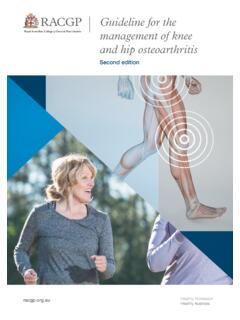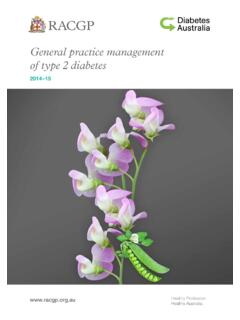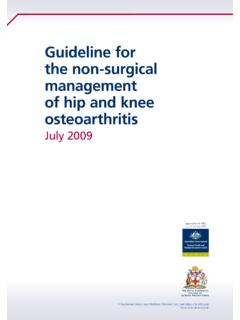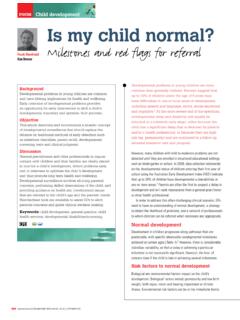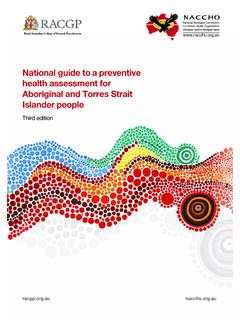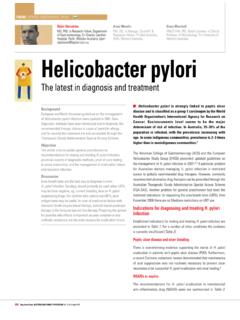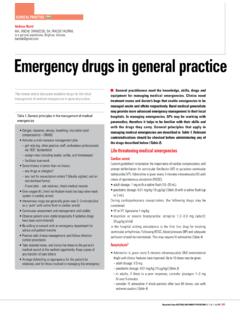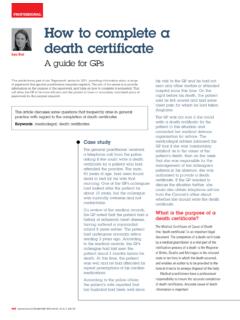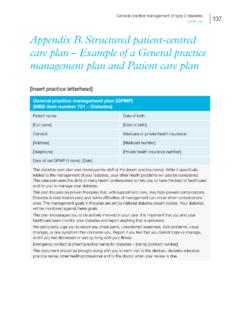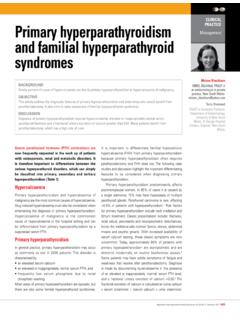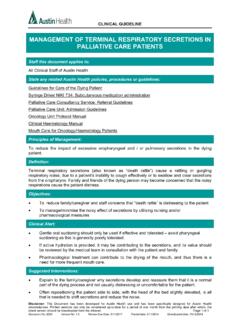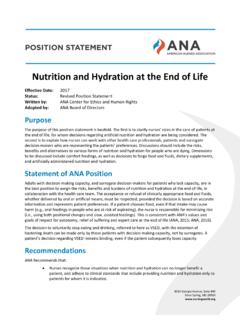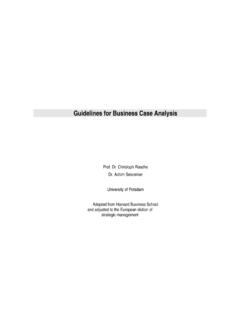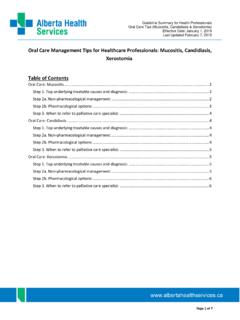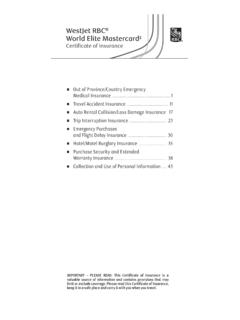Transcription of Managing COVID-19 at home with assistance from your ...
1 COVID-19 at home with assistance from your general practiceA guide, action plan and symptom diary for patientsManaging COVID-19 at home with assistance from your general practice: A guide, action plan and symptom diary for patientsDisclaimerThe information set out in this publication is current at the date of first publication and is intended for use as a guide of a general nature only and may or may not be relevant to particular patients or circumstances. Nor is this publication exhaustive of the subject matter. Persons implementing any recommendations contained in this publication must exercise their own independent skill or judgement or seek appropriate professional advice relevant to their own particular circumstances when so doing.
2 Compliance with any recommendations cannot of itself guarantee discharge of the duty of care owed to patients and others coming into contact with the health professional and the premises from which the health professional the text is directed to health professionals possessing appropriate qualifications and skills in ascertaining and discharging their professional (including legal) duties, it is not to be regarded as clinical advice and, in particular, is no substitute for a full examination and consideration of medical history in reaching a diagnosis and treatment based on accepted clinical , The Royal Australian College of General Practitioners Ltd (RACGP) and its employees and agents shall have no liability (including without limitation liability by reason of negligence) to any users of the information contained in this publication for any loss or damage (consequential or otherwise), cost or expense incurred or arising by reason of any person using or relying on the information contained in this publication and whether caused by reason of any error, negligent act, omission or misrepresentation in the citationThe Royal Australian College of General Practitioners.
3 Managing COVID-19 at home with assistance from your general practice: A guide, action plan and symptom diary for patients. East Melbourne, Vic: RACGP, Royal Australian College of General Practitioners Ltd 100 Wellington Parade East Melbourne, Victoria 3002 Tel 03 8699 0414 Fax 03 8699 0400 : 34 000 223 807 ISBN: 978-0-86906-419-1 Published September 2020, updated December 2021 The Royal Australian College of General Practitioners 2021 This resource is provided under licence by the RACGP. Full terms are available at In summary, you must not edit or adapt it or use it for any commercial purposes. You must acknowledge the RACGP as the acknowledge the Traditional Custodians of the lands and seas on which we work and live, and pay our respects to Elders, past, present and COVID-19 at home with assistance from your general practice | iContentsAbout this guide 1 What do I need to do when isolating at home?
4 3 What can I do to stop the spread of the virus? 4 What can I do to help manage my COVID-19 at home? 5 What symptoms might I have with COVID-19 ? 6 How do I check my oxygen level, heart rate (pulse), 7 respiratory rate (breathing) and temperature?What can I do to take care of my mental health and wellbeing? 10 What do I tell my work, and what financial supports are available 11 if I cannot work?What do I do at the end of my isolation? 11 When do I get vaccinated (or have my booster) after 12 having COVID-19 ? What information do I give my caregiver and other people in 12 the household?I am a parent, guardian or carer of a child with COVID-19 13 What do I need to know?Further information 14 References 14 Extra resources 15My COVID-19 action plan 15My daily symptom diary 19 Managing COVID-19 at home with assistance from your general practice | 1 About this guideThis guide is for people who have been diagnosed with COVID-19 and have mild to moderate symptoms.
5 If you have been diagnosed with COVID-19 , you must follow the instructions given to you by your local public health unit, health department, hospital or general practitioner (GP).If you have no symptoms, or your symptoms are mild to moderate, it is usually safe for you to isolate and manage your symptoms at home. If you are recovering in your home instead of going to hospital, your care team could include your GP, nurse, Aboriginal and Torres Strait Islander health practitioner and the local public health unit. Remember: It is normal for COVID-19 symptoms to change over time. Some people will have no symptoms and some people s symptoms might become worse over a couple of weeks.
6 This guide is designed to help you understand what to expect when you are diagnosed with COVID-19 , and what to look out for so that you know if your COVID-19 is getting people with COVID-19 will recover without needing to go to hospital or any special treatment. All COVID-19 patients need to be monitored closely while they recover at home. This is how we can keep them safe with regular you will have regular contact with your health providers, you will need to continue to monitor your own health as well throughout this time. To help you to monitor your health at home, you will need some equipment, including a thermometer and a pulse oximeter. Exactly what you will need and how you can get hold of this equipment is explained later in the not wait for your health provider to contact you if you have symptoms that are causing you COVID-19 action plan and symptom diaryThe My COVID-19 action plan and My daily symptom diary can be found at the end of this guide in the Extra resources section.
7 The action plan should be filled out with the support of your GP and nurse during your first telehealth appointment. You will need to keep this somewhere easy to find. We recommend that you share this with a household member or a friend you trust who can regularly check in with you each day while you are in isolation. If you need to speak with a healthcare professional, or if you call for an ambulance, then show them this action will need to fill out the My daily symptom diary at least once every day while you are isolating at home. Your GP or nurse might ask you to continue to fill in the symptoms more frequently or for a longer period of time. The My daily symptom diary will help you to keep a check on how you are feeling.
8 It will also help your GP or nurse check on your symptoms and determine if your management plan needs | Managing COVID-19 at home with assistance from your general practiceYour telehealth check-ups While you are isolating at home with COVID-19 , you will have regular telehealth consultations (check-ups) with your GP or nurse. It is best if you can use video for these check-ups, otherwise phone check-ups will be used. How often you have these check-ups and how long they go for will depend on how severe your symptoms are and how your health was before you were infected with COVID-19 . This will also depend on how comfortable you are feeling at home, how much support you have and how well you are recovering from COVID-19 .
9 Your GP or nurse will organise these appointments, but you can ask for them to be more often. You can add them to the My COVID-19 action plan in the Extra resources section at the end of this guide. In most cases, you will not need a face-to-face appointment during your isolation, but your GP or nurse will discuss this with you. At these check-ups, ask the GP or nurse any questions you have and let them know of any concerns. COVID-19 assistance in your languageYou can access COVID-19 assistance in your language by calling the National Coronavirus Helpline on 1800 020 080 and selecting option 5 for interpreter can access the Centrelink multilingual phone service on 131 202. Managing COVID-19 at home with assistance from your general practice | 3 What do I need to do when isolating at home?
10 Anyone diagnosed with COVID-19 must isolate to prevent the spread of infection. Isolating when you are infectious which means that you have the virus and can pass it on to others protects your family, friends and the wider community from COVID-19 . Isolation is a public health involves: staying at home, unless you need to leave to get medical care or if you feel unsafe in your home do not attend work or school, do not visit public areas, and do not travel on public transport, in taxis or ride-share services always call ahead before attending a healthcare or family violence service or police. You must advise them that you have COVID-19 in many cases you will be able to receive medical care using telehealth (using a phone or video), and medicines can be arranged by your pharmacist or GP to be delivered to your home living in a separate room away from other people in your household if you can stay in a separate, well-ventilated room away from the other people in your household who are COVID-19 negative, you should do so if you cannot isolate in a separate room, avoid shared spaces in the house as much as possible and wear a mask when moving through shared areas, and wipe down any surfaces you touch if you can, use a separate bathroom that others do not use.
